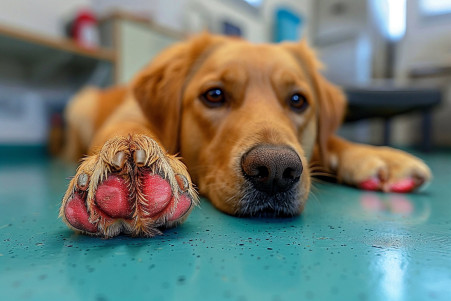Red Bump on Dog's Paw: Causes and Treatments Explained
26 May 2024 • Updated 25 May 2024

If you've noticed a red, irritated bump on your dog's paw, you may be worried about what it is. While paw pad injuries, interdigital cysts, and masses like histiocytoma and mast cell tumors can cause lumps and bumps on a dog's paws, red bumps are a sign that you should take your dog to the vet to find out what's going on.
To shed light on some of the most common causes of red bumps on a dog's paws, we've compiled information from studies in veterinary medicine and skin biology, as well as anecdotal evidence from pet owners and professionals. From minor issues to more serious skin problems, this investigation is designed to give you the information you need to better understand your dog's paw health and determine whether that annoying bump is something that needs to be checked out by a vet.
What causes red bumps on a dog's paw?
Interdigital Cysts: A Common Cause of Red Bumps on Dog Paws
Interdigital cysts are painful, fluid-filled swellings that occur between a dog's toes or paw pads. As described in this article, they originate in the deeper layers of the skin and are pushed to the surface as raised, red nodules that are often the result of a bacterial infection.
Many things can cause cysts to form, including breed. Certain breeds, such as the Labrador Retriever and the English Bulldog, have more webbing and shorter hair between their toes, which can lead to the hair becoming ingrown and causing irritation. Allergies, obesity, which can put more pressure on the paws, and trauma from grass awns or foxtails can also cause cysts, according to VCA Animal Hospitals.
Symptoms of interdigital cysts include redness, swelling, odor, limping, and licking or biting at the affected paw. Dogs with short hair and those with a history of allergies are more likely to develop interdigital cysts.
While some cases may resolve on their own, it's important to get veterinary attention for interdigital cysts because they are prone to infection. If left untreated, they can result in abscesses, draining tracts or systemic illness, according to the Merck Veterinary Manual. It's important to get a proper diagnosis and treatment from a veterinarian to prevent complications.
Veterinary Diagnosis and Treatment of Paw Cysts
If a dog has a red bump on their paw, a veterinarian will typically work through a diagnostic process to determine the cause. This will involve a physical exam, skin cytology (microscopic examination of a sample from the bump), and possibly a biopsy, according to Veterinary Partner.
There are a variety of treatment options for interdigital cysts and other paw issues. These can include antibiotics, anti-inflammatories, and topical treatments to help with any skin infections or inflammation, says Kingsdale Animal Hospital. In some cases, surgery may be necessary to remove cysts that won't go away or that are infected.
In addition, veterinarians will work to treat any underlying issues that may be causing paw cysts, such as allergies, hormonal imbalances, or autoimmune diseases. The Merck Veterinary Manual explains that chronic, recurring paw problems can be a sign of an underlying disease that needs to be diagnosed and treated.
Early treatment is important to avoid issues like infection or ongoing paw problems. However, Veterinary Partner says that some dogs with recurring interdigital cysts will need to be managed long-term, which may include things like lifestyle changes (e.g., weight management) or environmental changes.
Home Remedies and Natural Treatments for Paw Cysts
Per Dogs Naturally Magazine, there are a number of natural remedies and home treatments that can help with interdigital cysts and other paw problems in dogs. These include Epsom salt soaks, which can help draw out infections and foreign material, and antibacterial shampoos with essential oils like garlic, oregano, clove, or cinnamon that can help clean the area.
The article also suggests natural paw balms and pastes with ingredients like beeswax, shea butter, coconut oil, and antibacterial essential oils that can help calm and heal paw cysts. Foot baths with apple cider vinegar, iodine, baking soda, or herbal teas can also be used as a supportive measure.
That said, it's important to talk to a vet before trying any home remedies, as not all natural treatments may be safe for all dogs or conditions. It's also important to make sure to keep the area clean and dry to avoid further irritation or infection.
How to Tell If an Infection Is Present and When to See a Vet
It’s important to keep an eye on your dog’s paw to ensure that an infection doesn’t develop. If left untreated, interdigital cysts can lead to more serious issues. According to the Merck Veterinary Manual, early lesions can include redness and small nodules between the toes. If these aren’t treated, they can quickly turn into painful furuncles (boils) that contain pus and may rupture and exude bloody discharge.
The Merck Veterinary Manual also notes that cysts or comedones that become infected can cause lameness, draining tracts, and excessive licking or chewing at the site. If left untreated, the infection can turn into an abscess, become a chronic draining tract, or lead to systemic disease.
If you notice that the cyst seems to be getting worse or your dog is in pain, it’s important to see a vet as soon as possible. As the Kingsdale Animal Hospital explains, the vet can run tests like cytology or a biopsy to determine if the cyst is infected and needs to be treated with a specific remedy instead of a home treatment. It’s important to follow the vet’s advice to ensure that the issue doesn’t get worse.
Prevention and Foot Care for Healthy Dogs
Regular foot checks and proper grooming are important for catching and dealing with potential problems early, says Caninefitness.com. In particular, keeping the hair between a dog's toes trimmed and clean can help prevent interdigital cysts and other foot issues.
It's also important to manage any underlying issues that can make dogs more susceptible to foot problems, such as allergies, obesity, or arthritis, according to Kingsdale Animal Hospital. In addition, protective foot coverings like boots or wax-based products can help dogs who are prone to irritations or who spend time in extreme conditions, says What Doctors Don't Tell You.
Keeping a clean, safe home environment that's free from potential sources of foot trauma or irritation is important for preventing foot issues in dogs. With these prevention measures in place, dog owners can help ensure their pets have healthy feet and reduce the likelihood of interdigital cysts and other problems.
Conclusion: How to Keep Your Dog's Paws Healthy
This article has covered the most common causes of red bumps on a dog's paw, including interdigital cysts, paw pad injuries, and skin conditions. It has also stressed the importance of seeking veterinary care as soon as possible to identify the root cause of the problem and get the right treatment.
The article has also outlined the different treatment options available, from medical interventions to home remedies. It has also discussed the importance of preventive measures, such as regular paw checks, proper grooming, and environmental changes, in reducing the risk of paw problems in dogs.
Ultimately, healthy paws are essential for a dog's comfort, mobility, and overall well-being. Dog owners should be vigilant about monitoring their dog's paw health and consulting a veterinarian if they notice anything unusual. By taking a comprehensive approach to paw care, dog owners can help their pets live their best lives.


